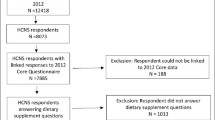Abstract
OBJECTIVE: To describe factors associated with vitamin supplement use in a large cohort of adult women.
METHODS: California teachers and administrators (n = 133,479) completed a questionnaire on lifestyle factors and medical history. Specific supplement users regularly used at least one specific vitamin supplement in the past year; multivitamin users regularly used a multivitamin; and multivitamin and specific supplement users took a multivitamin and one or more specific supplements. Associations between supplement use and other variables were quantified using means, cross-tabulations, and age-adjusted prevalence odds ratios.
RESULTS: Multivitamin and specific supplement users tended to be older and Caucasian. Compared to non-users, they were also leaner (odds ratio [OR] for BMI ≥ 30 kg/m2 = 0.6 for specific supplement users with or without multivitamins, and OR = 0.7 for multivitamin only users), and were less likely to be current smokers (OR for current smoking = 0.8 for multivitamin plus specific supplement users, OR = 0.9 for secific supplement only users, and OR = 0.7 for multivitamin only users). Specific supplement users (with or without multivitamins) were more likely to use cancer screening tests, eat fruits and vegetables, and exercise than were multivitamin only users or non-users.
CONCLUSIONS: A variety of demographic, dietary, and health-related factors were associated with different categories of supplement use.
Similar content being viewed by others
References
Harward MP (1993) Nutritive therapies for osteoporosis. The role of calcium. Med Clin North Am 77: 889–898.
Rayburn WF, Stanley JR, Garrett ME (1996) Periconceptional folate intake and neural tube defects. J Am Coll Nutr 15: 121–125.
Boushey CJ, Beresford SA, Omenn GS, Motulsky AG (1995) A quantitative assessment of plasma homocysteine as a risk factor for vascular disease. Probable benefits of increasing folic acid intakes. JAMA 274: 1049–1057.
Hatchcock J (1997) Vitamins and minerals: efficacy and safety. Am J Clin Nutr 66: 427–437.
Block G, Sinha R, Gridley G (1994) Collection of dietarysupplement data and implications for analysis. Am J Clin Nutr 59: 232S-239S.
Slesinski MJ, Subar AF, Kahle LL (1995) Trends in use of vitamin and mineral supplements in the United State: the 1987 and 1992 National Health Interview Surveys. J Am Diet Assoc 95: 921–923.
Lyle BJ, Mares-Perlman JA, Klein BE, Klein R, Greger JL (1998) Supplement users differ from nonusers in demographic, lifestyle, dietary and health characteristics. J Nutr 128: 2355–2362.
Patterson RE, Neuhouser ML, White E, Hunt JR, Kristal AR (1998) Cancer-related behavior of vitamin supplement users. Cancer Epidemiol Biomarkers Prev 7: 79–81.
Subar AF, Block G (1990) Use of vitamin and mineral supplements: demographics and amounts of nutrients consumed. The 1987 Health Interview Survey. Am J Epidemiol 132: 1091–1101.
Block G, Cox C, Madans J, Schreiber GB, Licitra L, Melia N (1988) Vitamin supplement use, by demographic characteristics. Am J Epidemiol 127: 297–309.
Bernstein L, Allen M, Anton-Culver H, et al. (2002) High breast cancer rates among California teachers: Results from the California Teachers Study Cohort. Cancer Causes Control 13: 625–635.
Block G, Hartman AM, Dresser CM, Carroll MD, Gannon J, Gardner L (1986) A data-based approach to diet questionnaire design and testing. Am J Epidemiol 124: 453–469.
Ervin RB, Wright JD, Kennedy-Stephenson J (1999) Use of dietary supplements in the United States, 1988–94. Vital Health Stat, Series 11 June; (244 ): i-iii, 1–14.
Kato I, Dnistrian AM, Schwartz M, et al. (1999) Epidemiologic correlates of serum folate and homocysteine levels among users and non-users of vitamin supplement. Int J Vitam Nutr Res 69: 322–329.
Newman V, Rock CL, Faerber S, Flatt SW, Wright FA, Pierce JP (1998) Dietary supplement use by women at risk for breast cancer recurrence. The Women's Healthy Eating and Living Study Group. J Am Diet Assoc 98: 285–292.
Gray SL, Hanlon JT, Fillenbaum GG, Wall WE, Bales C (1996) Predictors of nutritional supplement use by the elderly. Pharmacotherapy 16: 715–720.
Bender MM, Levy AS, Schucker RE, Yetley EA (1992) Trends in prevalence and magnitude of vitamin and mineral supplement usage and correlation with health status. J Am Diet Assoc 92: 1096–1101.
Gray GE, Paganini-Hill A, Ross RK (1983) Dietary intake and nutrient supplement use in a Southern California retirement community. Am J Clin Nutr 38: 122–128.
White E, Shannon JS, Patterson RE (1997) Relationship between vitamin and calcium supplement use and colon cancer. Cancer Epidemiol Biomarkers Prev 6: 769–774.
Author information
Authors and Affiliations
Rights and permissions
About this article
Cite this article
Hoggatt, K., Bernstein, L., Reynolds, P. et al. Correlates of vitamin supplement use in the United States: data from the California Teachers Study cohort. Cancer Causes Control 13, 735–740 (2002). https://doi.org/10.1023/A:1020282927074
Issue Date:
DOI: https://doi.org/10.1023/A:1020282927074




